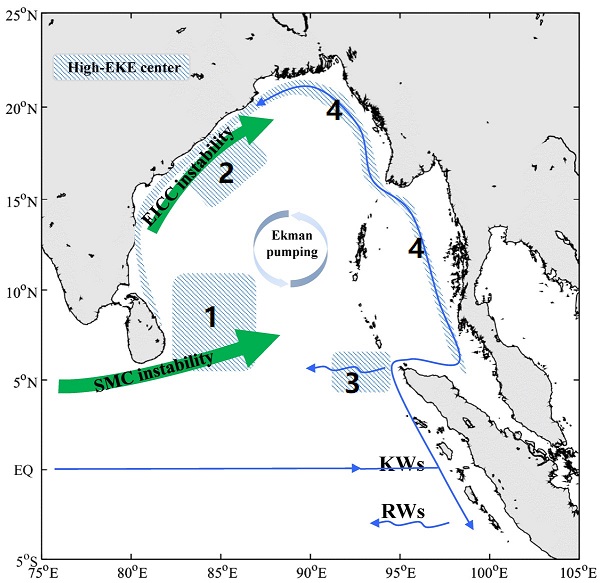Equatorial-origin wave signals contributing to the Eddy Kinetic Energy in the Bay of Bengal

Figure 1. Schematic showing the high-EKE centers in the BOB (shading areas) and the forcing mechanisms. Abbreviations: SMC: Southwest Monsoon Current, EICC: East Indian Coast Current, KWs: Kelvin waves, RWs: Rossby waves.
The Bay of Bengal (BOB) is a semiclosed marginal sea located in the tropical northeastern Indian Ocean. The complicated communications between the BOB and the equatorial Indian Ocean through both ocean and atmospheric teleconnections are one of the most important aspects of the tropical Indian Ocean climate. By analyzing satellite observational data and ocean general circulation model experiments, this study investigates the key processes that determine the spatial distribution and seasonality of intraseasonal eddy kinetic energy (EKE) within the Bay of Bengal (BOB). It is revealed that a complicated mechanism involving both local and remote wind forcing and ocean internal instability is responsible for the generation and modulation of EKE in this region. High-level EKE mainly resides in four regions: east of Sri Lanka (Region 1; shading area in Figure 1), the western BOB (Region 2), northwest of Sumatra (Region 3), and the coastal rim of the BOB (Region 4). The high EKE levels in Regions 1 and 2 are predominantly produced by ocean internal instability, which contributes 90% and 79%, respectively. Prominent seasonality is also observed in these two regions, with higher EKE levels in boreal spring and fall due to enhanced instability of the East Indian Coast Current and the Southwest Monsoon Current, respectively. In contrast, ocean internal instability contributes 49% and 52% of the total EKE in Regions 3 and 4, respectively, whereas the atmospheric forcing of intraseasonal oscillations (ISOs) also plays an important role. ISOs produce EKE mainly through wind stress, involving both the remote effect of equatorial winds and the local effect of monsoonal winds. Equatorial-origin wave signals significantly enhance the EKE levels in Regions 3 and 4, in the form of reflected Rossby waves and coastal Kelvin waves, respectively. The local wind-forcing effect through Ekman pumping also has a significant contribution in Regions 3 and 4 (24% and 22%, respectively).
(Summary written by Gengxin Chen)
*******************************************************
Origins of Eddy Kinetic Energy in the Bay of Bengal
Gengxin Chen1 , Yuanlong Li2,3 , Qiang Xie1,4, and Dongxiao Wang1
1. State Key Laboratory of Tropical Oceanography, South China Sea Institute of Oceanology, Chinese Academy of Sciences, Guangzhou, China,
2. Key Laboratory of Ocean Circulation and Waves, Institute of Oceanology, Chinese Academy of Sciences, Qingdao, China,
3. Function Laboratory for Ocean Dynamics and Climate, Qingdao National Laboratory for Marine Science and Technology, Qingdao, China, 4Sanya Institute of Deep-Sea Science and Engineering, Chinese Academy of Sciences, Sanya, China
Citation: Chen, G., Li, Y., Xie, Q., & Wang, D. (2018). Origins of eddy kinetic energy in the Bay of Bengal. Journal of Geophysical Research: Oceans, 123. https://doi.org/10.1002/2017JC013455













